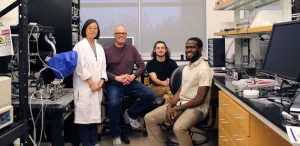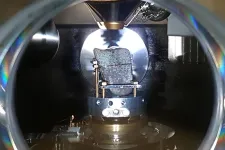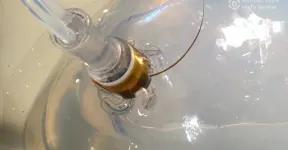How does the brain interpret taste?
By determining how neurons are receiving signals for taste and touch sensations, researchers aim to better understand how these integrations happen and whether it is reflective of an emotional correlation
2023-05-10
(Press-News.org) NORMAN, OKLA. – Taste is a complex neurological experience that has the potential to provide extensive, and perhaps surprising, information on how the brain makes sense of sensations and the organization of brain pathways. A research project funded by the National Institutes of Health, led by Christian H. Lemon, Ph.D., an associate professor in the Department of Biology in the Dodge Family College of Arts and Sciences, aims to better understand how the brain processes taste and how those neural pathways can evolve.
Taste is connected to a range of neural activities such as the pleasure of tasting something sweet. Taste is a part of flavor, which includes the pain experienced in tasting a hot pepper. However, there is a gap in knowledge about how taste and flavor preferences develop and evolve over time.
“Taste is a component of flavor; it contributes sensations like saltiness and sweetness. When we're eating food, we get a lot of pleasure from taste and flavor, but taste is actually a sensory system that we really don't fully understand in terms of how it works in guiding eating behavior and also how it works in the brain,” Lemon said.
This project will build on a discovery made by Lemon’s research group while studying a part of the brain where taste sensations can excite neurons in the midbrain region. Importantly, many other senses from various parts of the body are processed in the same neural location, with preliminary data suggesting some body senses can activate brain cells excited by tastes. By determining how neurons are receiving signals for taste and touch sensations, Lemon’s study hopes to better understand how these integrations happen and whether it is reflective of an emotional correlation.
“There is a part of the brain that takes in sensory information from basically almost all over the body, and taste is a part of this. We're wanting to understand, essentially, how taste is mapping into this part of the brain, along with all of these other body sensations as well, with the idea that if we can understand this it might actually tell us more about how taste works and how the taste system and other senses are organized, and why there appears to be neural overlap between them” he said.
Lemon believes this neural correlation may be evidence of the brain “multitasking”, making use of limited brain cells to perform multiple functions for the body. Past research suggests there is a pattern to the way these brain signals are being put together that Lemon believes to be reflecting the emotions elicited by different sensations.
“Studies in the new grant will combine molecular, genetic and neurophysiological testing to examine the organization of brain circuits that support the intersection of taste and touch sensations, and how these circuits work to influence behavior,” he said.
Throughout the five-year project, Lemon aims to better understand how and why these signals come together and further define basic organizational principles of the brain relevant to health and disease.
###
About the Project
The project “Taste and Somatosensory Processing” is funded by an expected $1.9 million from the U.S. Department of Health and Human Services, National Institutes of Health, Project no. 2R01DC011579-12A1
About the University of Oklahoma Office of the Vice President for Research and Partnerships
The University of Oklahoma is a leading research university classified by the Carnegie Foundation in the highest tier of research universities in the nation. Faculty, staff and students at OU are tackling global challenges and accelerating the delivery of practical solutions that impact society in direct and tangible ways through research and creative activities. OU researchers expand foundational knowledge while moving beyond traditional academic boundaries, collaborating across disciplines and globally with other research institutions as well as decision makers and practitioners from industry, government and civil society to create and apply solutions for a better world. Find out more at ou.edu/research
END
[Attachments] See images for this press release:


ELSE PRESS RELEASES FROM THIS DATE:
2023-05-10
The Association for Computing Machinery (ACM) and the Computer Science Teachers Association (CSTA) announced four high school students were selected from among a pool of graduating high school seniors throughout the US for the ACM/CSTA Cutler-Bell Prize in High School Computing. Eligible students applied for the award by submitting a project/artifact that engages modern technology and computer science. A panel of judges selected the recipients based on the ingenuity, complexity, relevancy, and originality of their projects.
The Cutler-Bell Prize promotes ...
2023-05-10
Research Highlights
Abdominal aortic aneurysm, a weakening and ballooning of the aorta, the largest blood vessel in the body, may result in a life-threatening rupture.
In a small, preliminary study examining a potential treatment to keep small abdominal aortic aneurysms from growing to a dangerous size, intravenous administration of immune-modulating cells resulted in a significant decrease in pro-inflammatory cells, and with higher doses, there was a decrease in aneurysm size.
In a separate small study, people with abdominal aortic aneurysms ...
2023-05-10
The Science
Neutrinos are subatomic particles that interact with matter extremely weakly. They are produced in many types of radioactive decays, including in the core of the Sun and in nuclear reactors. Neutrinos are also impossible to block—they easily travel from the core of a nuclear reactor to a detector far away, and even through the Earth itself. Detecting the tiny signals from neutrinos therefore requires huge devices that are extremely sensitive. The SNO+ experiment has just shown that a detector filled with simple water can still detect reactor neutrinos, even though the neutrinos create only tiny signals in the detector.
The ...
2023-05-10
In a new study, participants showed more empathy for an online anthropomorphic artificial intelligence (A.I.) agent when it seemed to disclose personal information about itself while chatting with participants. Takahiro Tsumura of The Graduate University for Advanced Studies, SOKENDAI in Tokyo, Japan, and Seiji Yamada of the National Institute of Informatics, also in Tokyo, present these findings in the open-access journal PLOS ONE on May 10, 2023.
The use of A.I. in daily life is increasing, raising interest in factors that might contribute to the level of trust and acceptance people feel towards A.I. agents. Prior research has suggested that people are ...
2023-05-10
Bird and bat fatalities at wind turbines increase during seasonal migrations – information which could aid their protection, according to a study published May 10, 2023 in the open-access journal PLOS ONE by John D. Lloyd from the Renewable Energy Wildlife Institute of Washington DC, USA, and colleagues.
While there have been local and regional studies on bird and bat deaths caused by wind turbines, this study looks at data from 248 wind turbine facilities across the United States—almost 30 percent ...
2023-05-10
The geochemistry of copper artefacts reveals changes in distribution networks across prehistoric Europe, according to a study published May 10, 2023 in the open-access journal PLOS ONE by Jan Piet Brozio of Kiel University, Germany and colleagues.
Early copper artefacts are considered to have a high cultural and historical significance in European prehistory, but limited information exists about how copper was used and distributed in Neolithic Europe. In this study, the authors analyzed 45 copper objects, including axes, chisels, and other items, from various sites dating to the 4th and 3rd millennia BC of Northern Central Europe and Southern ...
2023-05-10
Article URL: https://journals.plos.org/plosone/article?id=10.1371/journal.pone.0284570
Article Title: Metabolomics during canine pregnancy and lactation
Author Countries: Switzerland, Germany, Finland
Funding: The costs were covered by the Freie Universitaet Berlin (examination, sampling) without any specific funding and PetBiomics Ltd provided material support (Analyses). PetBiomics Ltd employee Claudia Ottka and PetBiomics Ltd chairman Hannes Lohi were involved in the analysis and the preparation of the manuscript. The funders had no role in study design, data collection and decision to publish. END ...
2023-05-10
The catastrophic Australian bushfires in 2019-2020 contributed to ocean cooling thousands of miles away, ultimately nudging the Tropical Pacific into a rare multi-year La Niña event that dissipated only recently.
The research was led by the National Center for Atmospheric Research (NCAR) and in Science Advances.
La Niña events tend to impact the winter climate over North America, causing drier and warmer than average conditions in the southwest U.S., wetter weather in the Pacific Northwest, and colder temperatures in Canada and the northern U.S. Because the emergence of La Niña can ...
2023-05-10
Stephanie Lacour’s specialty is the development of flexible electrodes that adapt to a moving body, providing more reliable connections with the nervous system. Her work is inherently interdisciplinary.
So when a neurosurgeon asked Lacour and her team to come up with minimally invasive electrodes for inserting through a human skull, they came up with an elegant solution that takes full advantage of their expertise in compliant electrodes, and inspired by soft robotics actuation. The results are published in Science Robotics.
The challenge? To insert a large cortical electrode array through a small hole in the skull, deploying the device in a space that measures about ...
2023-05-10
In an effort to improve fairness or reduce backlogs, machine-learning models are sometimes designed to mimic human decision making, such as deciding whether social media posts violate toxic content policies.
But researchers from MIT and elsewhere have found that these models often do not replicate human decisions about rule violations. If models are not trained with the right data, they are likely to make different, often harsher judgements than humans would.
In this case, the “right” data are those that have been labeled by humans who were explicitly asked whether items defy a certain rule. Training involves showing a machine-learning ...
LAST 30 PRESS RELEASES:
[Press-News.org] How does the brain interpret taste?
By determining how neurons are receiving signals for taste and touch sensations, researchers aim to better understand how these integrations happen and whether it is reflective of an emotional correlation








